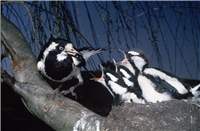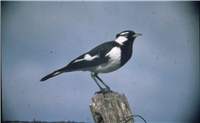Family
Dicruridae
Genus
Gralina
Species
cyanoleuca
Threats/Control Methods - Regional
The Common Koel (Eudynamys scolopacea ) may visit the nest of the Magpie -lark, pushing out its young. Prolonged droughts will pose a threat to this water dependant species.
Threats/Control Methods - Local
The Magpie -lack has adapted extremely well to the urban environment and its aggressive nature means it is only slightly threatened by free roaming domestic Cats (Felis catus).
Local/Urban Actions
Magpie-lark numbers are increasing across the suburbs and should not be encouraged by hand feeding. Excessive irrigation of lawns and gardens may encourage this species to nest close by, possibly excluding other less aggressive native species into the area. The threats to all native birds will be decreased if cat owners provide a stimulating indoor environment for their pet and an outdoor enclosure.
Common Names
Magpie Lark, Pee Wee, Peewee, Little Magpie, Murray Magpie, Peewit, Mudlark
Distinguishing Features
The Magpie-lark is a 26-30cm sized bird with distinctive black and white markings over its body. The adult male Magpie -lark has a white eyebrow and black face, while the female has an all-white face with no white eyebrow. The species has a thin white bill and pale coloured eyes.
Survey Techniques
Call and visual identification.
Species Call
A 'pee-o-wit' or 'pee-wee' call is frequently given as a duet.
Similar Species
The Magpie-lark has similar bold black and white markings to the Australian Magpie (Gymnorhina tibicen ), however the lark is significantly smaller and has a very different call.
Distribution
The species is found commonly right across the Australian mainland and into southern Guinea and Timor.
Country of Origin
Australia.
Conservation (Pet/Pest) Status - Regional
The ACT population has been growing fairly steadily over the past 20 years (COG).
Conservation (Pet/Pest) Status - National
Secure, not listed under the EPBC Act 1999.
LSCCES Population
The Magpie -lark was found across the catchment, with preference for the city and suburban areas.
Associated vegetation community
Magpie-larks are found in almost any Australian habitat except rainforests and extremely dry deserts. They are commonly urban birds, as they prefer open environments that have been cleared and provide permenant water sources.
Limiting Resources
This species required open landscapes with scattered trees and surface water for building mud nests.
Breeding
Nesting beings in September and runs through until December. The job of building their unique mud nests is shared between the male and female, who sit side by side and call alternately, each raising and lowering their wings as they do so. The full breeding cycle can take up to 17 weeks, however some pairs will squeeze two broods into the one summer. The 3-5 pink-white eggs are marked with red and purple-brown blotches. Both parents share incubation for 17-18 days. The young birds are ready to fly after 18-23 days in the nest.
Behaviour
Magpie-larks are commonly seen in pairs, although in autumn they can often be seen is large flock around the suburbs. They pick at soft, moist ground for insects and earthworms. During the breeding season, both males and females perch side by side and call loudly in a duet, heads up and tails fanned. They are very territorial birds and males can be aggressive, sometimes seen attacking their own reflections in car mirrors and building windows. When nesting, people may also be attacked.
Functional Group
Food Species
The Magpie -lark is mostly ground dwelling, and is usually seen slowly searching on the ground for a variety of insects and their larvae, as well as earthworms and freshwater invertebrates.
Predators
Young birds in their first year of life are especially prone to attacks from feral or domestic Cats (Felis catus).
Interesting Fact
Magpie-lark breeding partners preform a duet, one calling musically and the other talking a percussion role, each raising their wings and bowing to their song.
References - (reader suitability of references, P=Primary teachers, S=Secondary students, T=Tertiary students and researchers)
Books:
Morcomber, M. 2000. Field guide to Australian Birds. Steve Parish Publishing, Archerfield. P, S, T
Pizzey, G. 2000. The Graham Pizzey & Frank Knight Field Guide to the Birds of Australia. Angus & Robertson, Sydney. P, S, T
Schodde, R. and Tideman, S. (eds) 1990. Reader's Digest Complete Book of Australian Birds (2nd Edition). Reader's Digest Services Pty Ltd. Sydney. P, S, T
Veerman, P. 2003. Canberra Birds: A report on the first 21 years of the garden bird survey. Philip Veerman and Canberra Ornithologists Group. Canberra. S, T
Internet:
Birds in Backyards 2006. [online]. Available at:
http://www.birdsinbackyards.net P, S, T
Canberra Ornithological Group (COG). 2004. Birds of Canberra Gardens. COG and the ACT Department of Urban Services. [online]. Available at:
http://garden.canberrabirds.org.au/ P, S, T
Online Publications:
Nix, H. and Cunningham, R. 2006. Birds of the Lower Sullivans Creek Catchment, Canberra ACT. Prepared for the Life in the Suburbs project using data from the Lower Sullivans Creek Catchment Ecological Survey (LSCCES). Australian National University. Canberra. [online]. Available at: http://www.lifeinthesuburbs.com.au/category.php?id=65 S, T


 Top
Top Top
Top